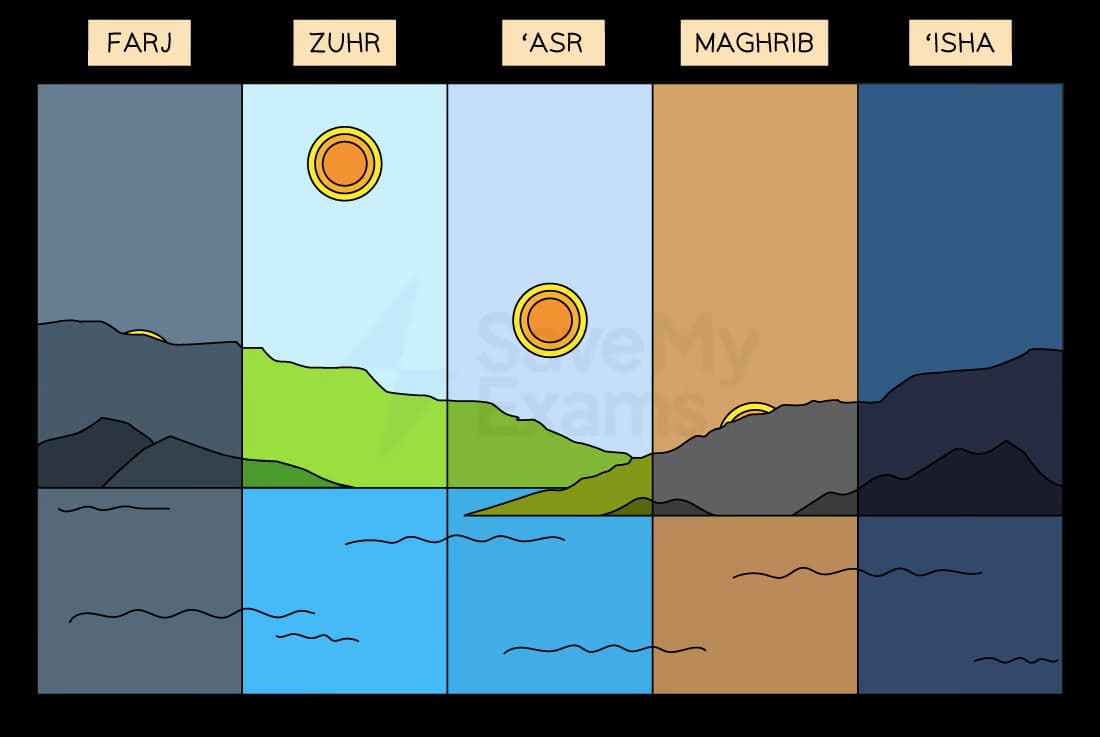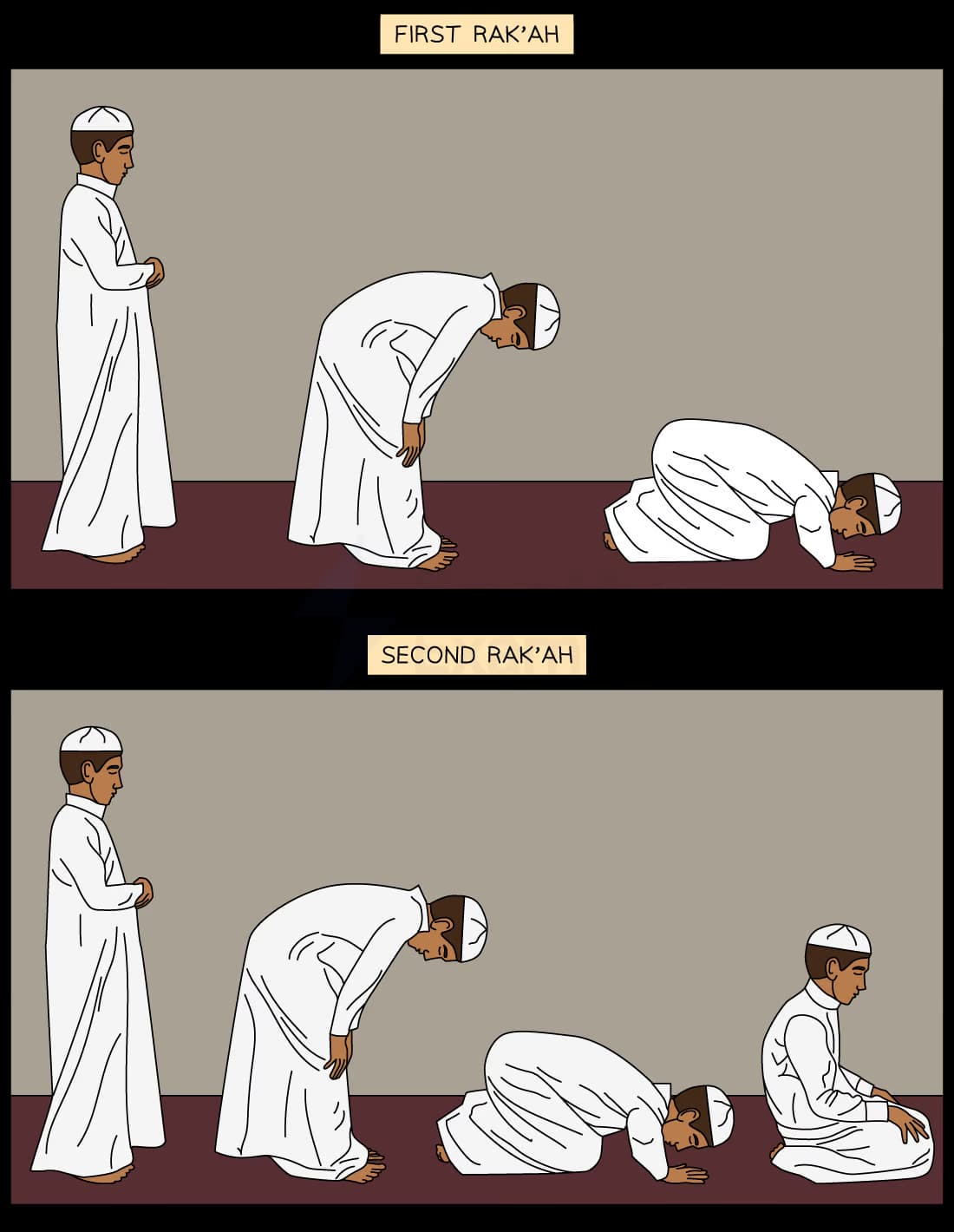What is Salah? (Edexcel GCSE Religious Studies B): Revision Note
Exam code: 1RB0
The Nature & Purpose of Salah for Muslims
The History and Significance of Salah
Salah is the second of the Five Pillars of Islam and one of the Ten Obligatory Acts for Shi’a Muslims
It is the compulsory prayer that takes place five times each day
The Qur’an teaches Muslims about Salah
‘Celebrate the glory of your Lord and be among those who bow down to Him: worship your Lord until what is certain comes to you’ (Surah 15:98-99)
‘What is certain’ in this context means death, so this passage calls on believers to worship Allah for their entire lifetime
This passage also mentions bowing down to Allah, which is a key element of performing Salah
All of the prophets taught about worship, and the Prophet Muhammad showed Muslims how they should pray
The Purpose of Salah for Muslims
Muslims believe that through Salah they can communicate directly with Allah
Therefore praying five times a day can deepen their relationship with Allah
They will also pray to seek help if they are troubled
‘I respond to those who call Me, so let them respond to Me, and believe in Me, so they may be guided’ (Qur’an, Surah 2:186)
They will pray to help to improve their behaviour
‘Keep up the prayer, prayer strengthens outrageous and unacceptable behaviour’ (Qur’an, Surah 29:45)
Praying five times a day is obligatory for all adults to show their commitment to their faith
Children are encouraged to participate and develop the practice of prayer, they will learn to pray from a very young age as they grow up in the Muslim faith
The Prophet Muhammad said that the first question Allah will ask his followers in the akhirah (afterlife) will be about Salah
How Salah is Performed
The Timing of Salah
Muslims will perform Salah at set times of the day, because the Qur’an teaches
‘Keep up regular prayer, for prayer is obligatory for the believers at prescribed times’ (Surah 4:103)
These times are: just after dawn, just after midday, late afternoon, just after sunset and after dark
In practice, life and work commitments make it difficult always to observe all of these times, and therefore some prayers can be combined (Shi’a Muslims commonly do this)
The times of Salah

Ablution in Preparation for Salah
It is important to be clean for Salah, so Muslims will perform wudu, or ablution
This is a process of ritual washing. Believers will clean their hands, feet and face
While they do this, they will reflect on their Niyyah (intentions) for their prayer
This process prepares Muslims both physically and spiritually for Salah
The Process of Salah
Muslims will face the city of Makkah for Salah, because it is where the Ka’aba is located
This direction of prayer is called qiblah
During prayer, Muslims perform a set sequence of movements called a rak’ah as they pray
Movements in the sequence include
Standing (qiyam)
Bowing (ruku’)
Prostrating (sajdah)
Kneeling (qa’dah)
Salah Prayer Sequence

Muslims recite set prayers in Arabic from the Qur’an, Sunnah, and Hadith
Performing Salah at the Mosque
Salah can be done anywhere, but most Muslims pray either in the mosque or at home
Because the mosque is dedicated to offering prayer, it is a peaceful place to perform Salah, and it is easy to perform Wudu
Salah at the mosque is considered to carry more blessings
The Hadith says ‘Prayer with the congregation is 27 times better than prayer performed by oneself’
It also creates unity between believers and strengthens their bonds
There are strict rules about Salah at the mosque
Muslims must enter calmly
Cover their heads
Remove their shoes
Switch off electronic devices such as phones
Remain silent after greeting other worshippers with the greeting ‘peace be upon you’
The adhan (call to prayer) signals the start of Salah
An imam leads the prayer
There is a mihrab (niche) in the wall to show which direction worshippers should stand to face Makkah
The worshippers will stand in rows, shoulder to shoulder
Men and women do not pray together, they have separate prayer areas
Performing Salah at Home
Prayer can be performed anywhere, as long as wudu is performed, and the place is clean
Many Muslims perform Salah at home, and in some places women do not ever attend the mosque and always pray at home
The Prophet Muhammad encouraged followers to pray in their houses
‘Pray in your houses – do not make them like graveyards’ (Hadith – Sahih Al-Bukhari)
Praying at home can help children to learn about prayer
Jummah Prayer
Jummah prayer is the most important prayer of the whole week
It takes place in the mosque each Friday
All Muslims try to attend Jummah, a special service where the imam will offer a sermon and there is the opportunity for sins to be forgiven
‘He who comes … to Jummah …offers the Salah and listens quietly when the Imam stands up for the sermon, will have his sins forgiven’ (Hadith – Sahih Al-Bukhari)
Divergent Understanding of Salah in Islam
Both Shi’a and Sunni Muslims offer daily prayers, but there are some differences in how they happen
Divergent Understanding of Salah
Sunni Muslims | Shi’a Muslims |
|---|---|
Perform Salah at five prayer times each day | Combine the five daily prayers into three sessions |
Move head from left to right at the end of prayer | Raise their hands three times to Allah at the end of prayer |
Prostrate themselves by touching their heads to the floor | Place a small block of wood or earth on the floor (turbah) so that their head touches something natural when they prostrate themselves, reminding them that they have come from the earth and will return to it after death |
Worked Example
Outline three reasons why Muslims pray
(3 marks)
Answer:
Muslims pray
To communicate directly with Allah (1 mark)
To deepen their relationship with Allah (1 mark)
To seek help if they are troubled (1 mark)
Examiner Tips and Tricks
In your exam, you may be asked to compare and contrast Salah in Islam with forms of prayer and worship in Christianity, which is the main religious tradition of Great Britain
Therefore, compare your revision on Salah with what you have learned about prayer and worship in Christianity and make sure you can explain similarities and differences between them
Differences include the main day of worship, types of prayers, actions, and content of the services (Christianity has several denominations, and so there is not one single form of worship)
Similarities include the idea of the community coming together to share in prayer, the use of prayer to communicate and strengthen their relationship with God, and worship making believers feel part of a larger community

Unlock more, it's free!
Did this page help you?